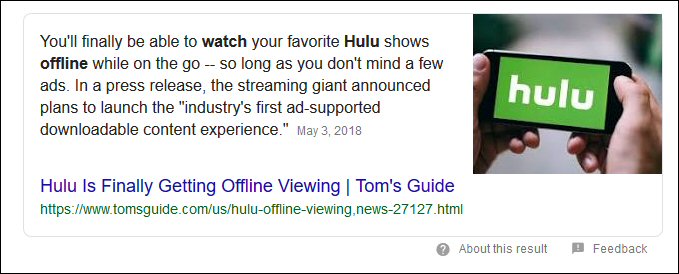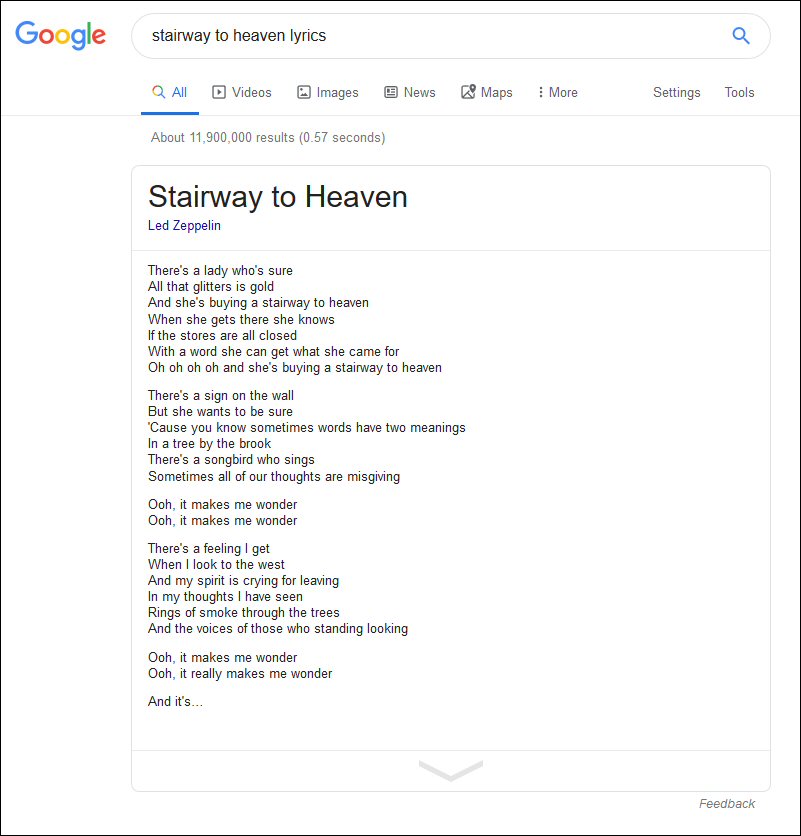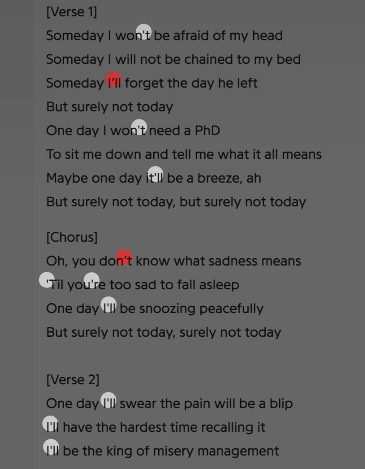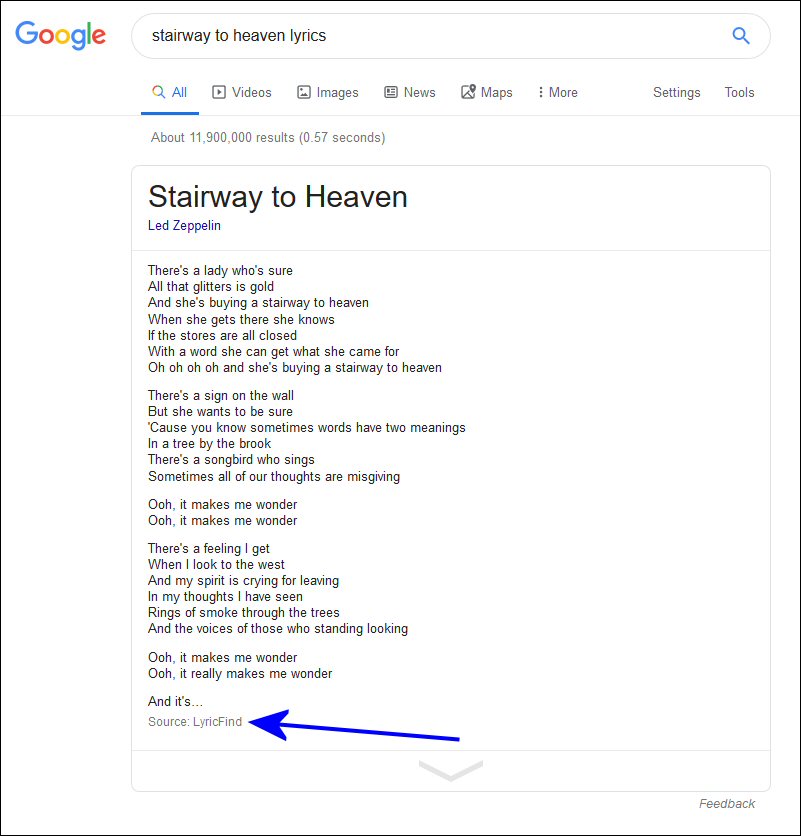Google: Facing the Music
The following is a quick study of the fascinating dynamics behind search page results. Most people don’t think too much about the complex nature of how Google arrives at its results, but that’s exactly what we do here at Five Blocks.
A Wall Street Journal story last month accused Google of sourcing content without giving credit to the source. The article said Google had been scraping music lyrics from genius.com, a popular lyrics site.
Some quick background: When you search for the lyrics of a song, Google often shows the lyrics in what’s called a “rich snippet”.
What are Rich Snippets? you may ask.
Rich snippets are boxes that contain content clipped directly from a third-party web page. Google uses these rich snippets because it is the fastest way to get searchers the answer to their query.
Here is an example:
This is all fine as long as Google credits the source – and ideally provides a link to click.
However, in the case of song lyrics, Google seems to have provided the name of the artist, but not the website the lyrics came from – below is an image from before the WSJ story was published:
As you can imagine, song lyrics appear on lots of sites. So how could Genius.com be so sure that Google was scraping their site?
They ran a test. They embedded patterns of apostrophes in the formatting of song lyrics. If this pattern was replicated in the rich snippet in search results, it would prove that genius.com was the original source. They used two different types of apostrophes throughout the lyrics, as below (as seen in the WSJ.com article referenced above):
Genius checked the rich snippet, and found the apostrophe pattern replicated, proving the content came from their site.
But now the plot thickens — a development we became aware of after recently sharing this story with our partners.
The lyrics site LyricFind offered a rebuttal of the WSJ story, citing their licensing agreement with Google, and claiming that the content came from their site.
In fact, in the days following the publication of the WSJ story, Google began showing LyricFind as the source, and including a link.
But what about Genius.com’s test? Here’s what LyricFind says:
“Some time ago…Genius notified LyricFind that they believed they were seeing Genius lyrics in LyricFind’s database. As a courtesy to Genius, our content team was instructed not to consult Genius as a source. Recently, Genius raised the issue again and provided a few examples. All of those examples were also available on many other lyric sites and services, raising the possibility that our team unknowingly sourced Genius lyrics from another location. [Italics ours. – YG]
As a result, LyricFind offered to remove any lyrics Genius felt had originated from them, even though we did not source them from Genius’ site. Genius declined to respond to that offer. Despite that, our team is currently investigating the content in our database and removing any lyrics that seem to have originated from Genius.”
In any event, it seems that Google, having implemented the change of crediting the source, has admitted that lyric sites, and not only artists, have certain rights — even if those are different than those held by the artist or publisher.
This episode is a reminder of how Google, with its complex automated systems that collect, process, categorize, and display information, needs to be closely monitored and managed.
In the same way that the system seems to have sourced content without proper attribution, that same mechanism often presents incorrect and damaging content about brands and individuals.
With so many stakeholders using Google to help them form opinions on people, companies, and issues, watching every detail related to Google’s top results is critical for your brand.
Another reminder that Intelligent Digital Reputation Management isn’t just “nice to have” — but an essential business strategy.
Chrome Hopes to Unblock your Ads – by Blocking Ads!
Building an online reputation involves targeting searchers with your brand’s messaging and ensuring that searchers see your preferred content. Using online advertising can be a great way to ensure that searchers encounter your messaging online. But now, the ability to laser target searchers by buying ads could be impacted by a new plan by Google to help millions of users block paid ads.
In mid-April the Wall Street Journal reported that Google is planning to build adblocking features into its Chrome web browser. While Google still may decide not to move ahead with this plan, if they do, this could become the default.
What is Adblocking?
Adblocking is the process of blocking online ads from appearing in a web browser. It generally works via a browser ‘add-on’ or ‘extension’ that can be downloaded for various browser types. The objective is to improve the browsing experience by stopping intrusive, annoying, or unhelpful ads from appearing within web pages.
Adblocking software has been available for about 15 years and while Adblock was the first (created in 2002 by a Danish student), there are now many popular adblocking programs available.
What will Google’s Chrome ad blocker do?
Rather than block all ads, as users may currently expect their adblockers to do, Google’s will emphasize filtering out specific types of ads that contribute to a poor user experience. The choice of which types of ads to block would follow standards released in March by industry group Coalition for Better Ads. These include:
- Pop-ups
- Video ads with sound that play automatically
- Ads with countdown timers that appear before a user can see a site’s content
This dovetails with Pagefair’s finding that interruptive ads are one of the leading motivations for adblock program usage.
What is the current extent of ad-blocking?
PageFair’s 2017 report revealed the wide ranging use of adblocking technologies:
- 11% of Internet users worldwide block ads on the web
- 615 million devices around the world are blocking ads
- 52 million devices in the US – 18% of internet users
- 11 million devices in the UK – 16% of internet users
- 12% of users in Central and Eastern Europe (including the UK)
Worldwide, use of adblockers on mobile devices (11%) has overtaken use on desktop (7%). However, mobile usage is still mostly limited to countries in Southeast Asia, while desktop usage is primarily in Western countries.
Adblocking software usage spans all ages (PageFair’s study looked at adults 18+, no children) though usage is higher among men than women.
Why is Google considering adding ad-blocking functionality?
It would seem counterintuitive for Google to offer the option to block ads on its browser; ads are Google’s main source of revenue, earning them over $60bn last year.
However, as indicated, Google is not planning to block everything; rather, according to the WSJ, it will ‘filter out certain online ad types deemed to provide bad experiences for users as they move around the web.’
Essentially, Google may be hoping that by improving the default experience on Chrome, users will abandon their third party blockers, providing a win-win for both the user and for Google. With a better experience, the user is more willing to view – and may be more likely to click – on the less intrusive ads they do see, ultimately increasing revenue to Google. Indeed, PageFair’s study found that 77% of adblock users would be open to viewing some ad formats.
Conclusion
While there has been no official announcement from Google regarding the addition of adblocking capabilities to the Chrome browser, the WSJ believes one could be made within weeks.
The full impact of adblocking on publishers and advertisers is difficult to predict, however the segments of (American) users most likely to use them are males and those with a bachelor’s degree (according to PageFair). Companies targeting these groups may currently be missing a wide swath of their potential market due to use of adblocking software.
If Google is planning something in this area, there is potential for advertisers to once again reach users who are currently blocking their ads. Either way, when thinking of how to target stakeholders, it is important to keep in mind that advertising is an important tool in the brand’s arsenal, but only if the ads are designed to be seen – and not blocked – by important market segments.





